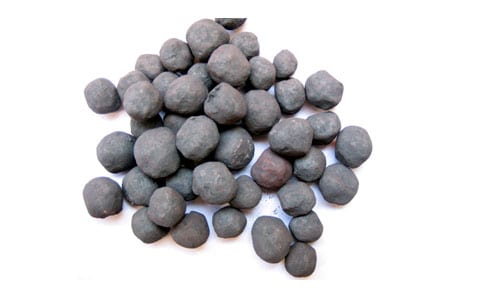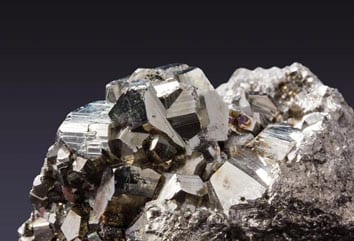Họrọ asụsụ:
Iron ore bụ nke anọ kasị mmewere na ụwa jikọrọ ọnụ. Iron dị oké mkpa ka ígwè n'ichepụta ya mere ihe dị oké mkpa ihe n'ihi na zuru ụwa ọnụ aku development. Iron na-n'ọtụtụ ebe na-ewu na n'ichepụta nke ugbo ala. Ọtụtụ n'ime ígwè ore ego na-ekewet nke metamorphosed kee ya agbụ ígwè formations (BIF) na nke ígwè na ọtụtụ ndị na-hụrụ na ụdị oxides, hydroxides na a nta ruo n'ókè carbonates.
The chemical mejupụtara nke ígwè ores nwere ihe yiri mbara nso na chemical mejupụtara karịsịa maka Fe ọdịnaya na metụtara gangue minerals. Isi ígwè minerals jikọtara kasị ígwè ores bụ hematite, goethite, limonite na magnetite. Isi contaminants na ígwè ores bụ SiO2 na Al2O3. Ahụkarị silica na alumina amị minerals ugbu a na ígwè ores bụ quartz, kaolinite, gibbsite, diaspore na corundum. Of these it is often observed that quartz is the main silica bearing mineral and kaolinite and gibbsite are the two-main alumina bearing minerals.


Iron ore mmịpụta na tumadi rụrụ site emeghe olulu Ngwuputa arụmọrụ, n'ihi na ịrịba tailings ọgbọ. The ígwè ore mmepụta usoro na-agụnyekarị atọ: Ngwuputa, nhazi na pelletizing eme. ndị a, nhazi ana achi achi na ihe zuru ezu ígwè ọkwa na onwu na-enweta tupu pelletizing ogbo. Nhazi agụnye ndinuak, nhazi ọkwa, egwe ọka, and concentration aiming at increasing the iron content while reducing the amount of gangue minerals. Onye ọ bụla ịnweta ego nwere ya pụrụ iche e ji mara na-akwanyere ígwè na gangue agba minerals, ya mere ọ na-achọ a dị iche iche ịta Usoro.
Magnetic separation is typically used in high-grade iron ore beneficiation where the dominant iron minerals are ferro and paramagnetic. Wet na akọrọ ala-osisi ike magnetik nkewa (LIMS) usoro na-eji hazie ores na ike magnetik Njirimara dị ka magnetite mgbe udu mmiri elu-osisi ike magnetik nkewa na-eji ikewara Fe-amị minerals na-adịghị ike magnetik Njirimara dị ka hematite si gangue minerals. Iron ores dị goethite na limonite ọtụtụ ndị na-hụrụ na tailings na anaghị ikewapụ nke ọma site ma Usoro.

Flotation a na-eji belata ọdịnaya nke adịghị na ala-ọkwa ígwè ores. Iron ores nwere ike lekwasị ma site kpọmkwem anionic flotation ígwè oxides ma ọ bụ laa azu cationic flotation nke silica, Otú ọ dị laa azu cationic flotation anọgide ndị kasị ewu ewu flotation uzo eji ígwè ụlọ ọrụ. The ojiji nke flotation ya oke site na-eri nke reagents, ọnụnọ nke silica na alumina-ọgaranya slimes na ọnụnọ nke carbonate minerals. Ọzọkwa, flotation achọ n'efu na mmiri ọgwụ na ojiji nke downstream dewatering akọrọ ikpeazụ ngwa.
The ojiji nke flotation maka ịta nke ígwè na-agụnye desliming ka sere n'elu na ọnụnọ nke Iwu na-arụpụta na-ebelata arụmọrụ na elu reagent akwụ ụgwọ. Desliming karịsịa oké egwu maka iwepụ alumina ka nkewa nke gibbsite si hematite ma ọ bụ goethite site ọ bụla n'elu-arụsi ọrụ ike mmadụ bụ nnọọ ihe siri ike. Ọtụtụ n'ime alumina amị minerals pụtara na mma size nso (<20um) allowing for its removal through desliming. n'ozuzu, a high concentration of fines (<20um) and alumina increases the required cationic collector dose and decreases selectivity dramatically. Therefore desliming increases flotation efficiency, but results in a large volume of tailings and in loss of iron to the tailings stream.
Dry processing of iron ore presents an opportunity to eliminate costs and wet tailings generation associated with flotation and wet magnetic separation circuits. STET has evaluated several iron ore tailings and run of mine ore samples at bench scale (pre-feasibility scale). Significant movement of iron and silicates was observed, with examples highlighted in the table below.

The results nke ọmụmụ a gosiri na ala-ọkwa ígwè ore Iwu nwere ike kwalite site STET tribo-electrostatic belt separator. Based on STET experience, ngwaahịa mgbake na / ma ọ bụ ọkwa ga budata melite na pilot ọnụ ọgụgụ nhazi, ka tụnyere bench-ọnụ ọgụgụ ule ngwaọrụ tinye n'ọrụ n'oge ndị a ígwè ore ọnwụnwa.
The STET dry electrostatic fine iron ore separation process offers many advantages over traditional wet processing methods, such as magnetics or flotation, tinyere:
Contact us to learn more about dry processing of iron ore.
References: